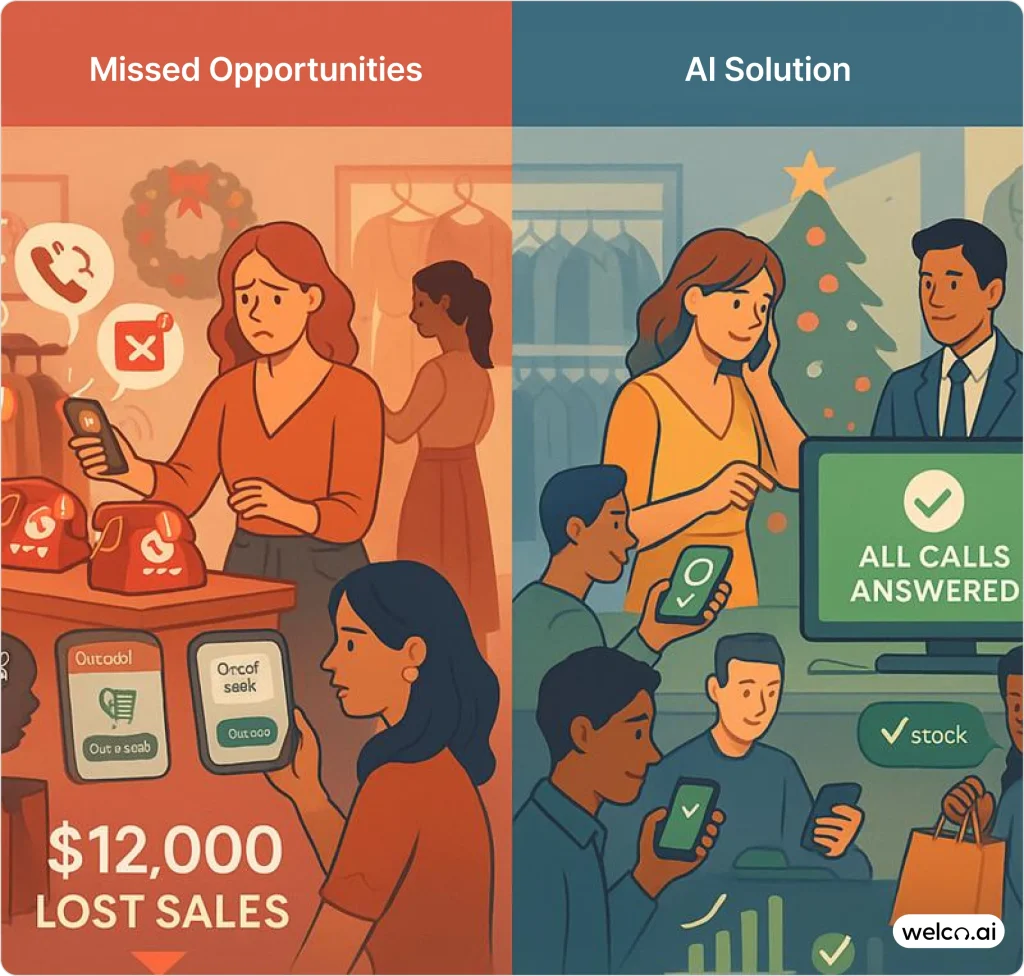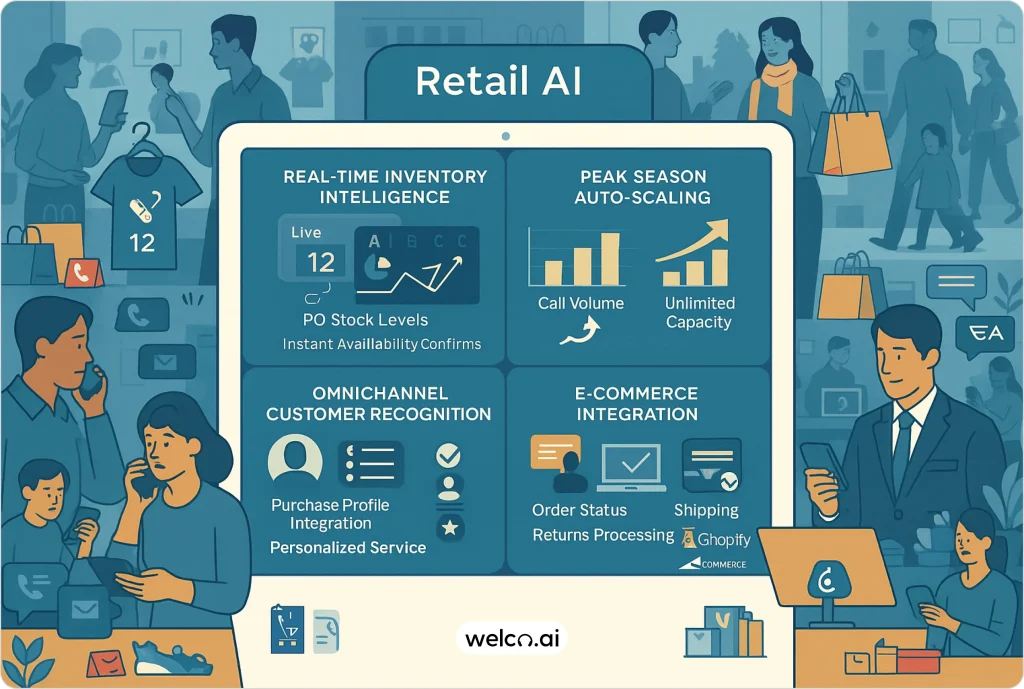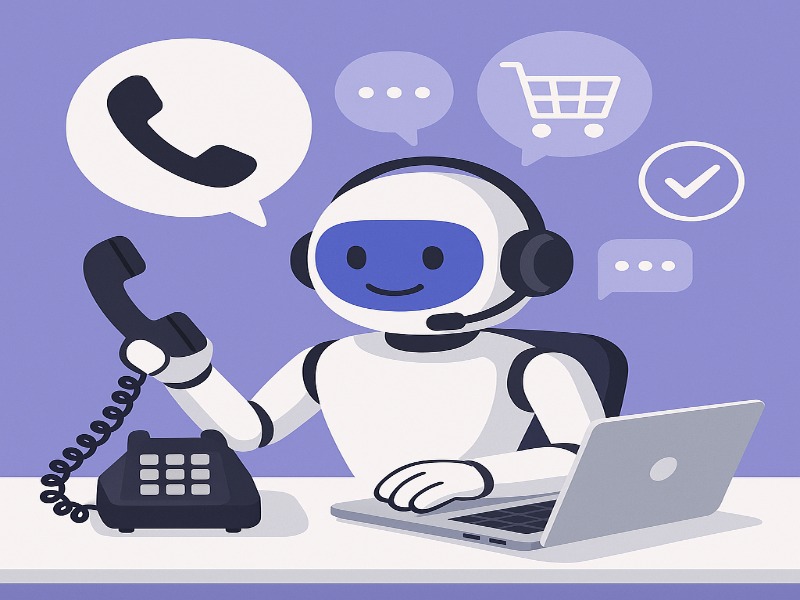The Evolution of Retail Customer Support: Why AI Phone Systems Still Matter
The retail landscape has evolved dramatically over the past decade. While e-commerce has revolutionized how customers shop, phone support remains a critical touchpoint that can make or break the customer experience.
According to Zendesk’s 2024 Customer Experience Trends Report, 67% of customers still prefer phone support for complex inquiries, returns, and urgent questions. This makes AI customer support retail solutions more valuable than ever.
Last Black Friday, Emma Rodriguez, who runs “Urban Threads,” a contemporary women’s boutique specializing in professional workwear for women aged 28-45 in downtown Austin, experienced this reality firsthand. Despite having a robust Shopify store and strong Instagram presence, her business lost $12,000 in potential sales – not from website crashes or inventory shortages, but from unanswered phone calls.
While Emma was helping one customer try on a holiday dress, seventeen online shoppers called with urgent questions: “Do you have this sweater in medium?” “Can I get this shipped by December 23rd?” “What’s your return policy for gift purchases?”
Each unanswered call meant a lost sale to competitors who could provide immediate assistance. “I felt helpless,” Emma recalls. “I could see my phone lighting up constantly, but I couldn’t abandon the customer in front of me. By the time I returned calls, most had already ordered elsewhere.”

This scenario illustrates a critical challenge facing modern retail: how to provide consistent, high-quality customer support across all channels without overwhelming staff or breaking the budget.
Key Insight: 78% of customers hang up after 3 rings, and 85% won’t call back after reaching voicemail during business hours. (BIA Advisory Services, 2024)
Understanding the True Cost of Missed Calls in Retail
Industry research from RingCentral’s 2024 Communications Report reveals concerning statistics about customer phone behavior:
- 78% of customers hang up after 3 rings
- 85% won’t call back after reaching voicemail during business hours
- 92% expect immediate answers to inventory and shipping questions
For retail and e-commerce businesses, every missed call represents multiple layers of lost value. This is why implementing an AI phone answering service has become crucial for competitive businesses.
Immediate Revenue Loss:
- Average lost sale value: $75-$200
- Customer acquisition cost wasted: $50-$150
Long-term Impact:
- Lifetime customer value lost: $500-$2,000
- Negative word-of-mouth potential
- Reduced brand trust and loyalty
Emma discovered this impact when she tracked her missed calls for one week. The results were startling: 47 missed calls translated to approximately $8,200 in lost revenue. Extrapolated annually, this represented over $400,000 in missed opportunities.
“I never realized how much money was literally ringing away from my business,” Emma says. “It was a wake-up call that changed everything.”
How Retailers Are Adapting with AI Phone Support Solutions
Leading retailers understand that customer support isn’t just about solving problems – it’s about creating seamless experiences that drive sales and build loyalty.
According to McKinsey’s 2024 Retail Technology Survey, successful businesses are implementing omnichannel customer support AI strategies that ensure consistency whether customers interact through phone, email, chat, or in-person. This comprehensive approach is being adopted across various industries, from small businesses seeking growth through improved reception to enterprises with complex operational needs.
The Traditional Reception Model: Why It’s No Longer Sufficient
Traditional human-only reception models face several challenges in today’s retail environment:
Financial Burden:
- Base salary: $35,000-$45,000 annually
- Benefits and overhead: $12,000-$19,000 annually
- Training costs: $3,000-$5,000 annually
- Coverage for sick days and breaks: $4,000-$8,000 annually
- Total annual cost: $54,000-$77,000
Operational Limitations:
- Cannot handle peak season customer support retail demands effectively
- Limited to business hours without overtime costs
- Can only manage one call at a time
- Requires constant training on new products and policies
- Inconsistent service quality due to human variables
Integration Challenges:
- Difficulty accessing real-time inventory across multiple channels
- Limited ability to provide instant order status updates
- Challenges maintaining customer history across touchpoints
The AI Solution: Transforming Retail Phone Support
Modern virtual phone receptionists, specifically designed for retail environments, address these challenges while enhancing the overall customer experience. These systems integrate seamlessly with existing retail infrastructure to provide comprehensive support across all customer touchpoints.
Similar AI phone solutions are transforming customer service across multiple industries. From AI receptionists for healthcare practices with HIPAA compliance to legal firms managing confidential call management, businesses are discovering the power of intelligent phone automation.
Emma’s Transformation: A Real Implementation Story
After researching various AI phone system options and dealing with three months of overwhelming holiday season calls, Emma implemented Welco.ai’s retail-focused AI receptionist in January 2024.
“I was skeptical at first,” Emma admits. “Would customers be put off by talking to an AI phone assistant? Would it understand our unique product lines and customer needs? The first week, I listened to every single call recording.”
Month 1 Results:
- Call answer rate improved from 60% to 100%
- After-hours sales captured: $4,200
- Customer complaints reduced by 80%
- Staff stress significantly decreased
- Improved focus on in-store customer experience
6-Month Results:
- Additional revenue generated: $47,000
- Operational cost savings: $32,000
- Customer satisfaction scores increased by 45%
- Total ROI: 340%
“The transformation has been remarkable,” Emma explains. “My AI phone receptionist handles routine inquiries flawlessly, allowing my team to focus on styling sessions and complex customer needs. We’re now capturing sales from late-night online shoppers who call with questions, and our customers actually prefer getting instant, accurate information.”
The unexpected challenge? Emma had to upgrade her inventory management system because the AI exposed how often her stock levels were inaccurate. “It forced us to get our operations in order, which was actually a blessing in disguise.”
Key Features That Drive Results in Retail Environments
Real-Time Inventory Intelligence
Unlike generic AI systems that provide outdated information, retail-specific AI phone solutions integrate directly with point-of-sale systems and inventory management platforms. This ensures customers receive accurate stock levels across all locations and channels instantly, eliminating the need for callbacks and reducing cart abandonment.
Peak Season Auto-Scaling
Seasonal traffic spikes can overwhelm traditional phone systems. During Black Friday, Cyber Monday, and holiday shopping periods, call volumes can increase by 1000% or more. Advanced automated phone answering retail systems automatically scale to handle unlimited traffic without performance degradation, ensuring no sales are lost during critical revenue periods.
This scalability challenge isn’t unique to retail. Healthcare practices with HIPAA compliance requirements face similar demands during flu seasons and health emergencies, where maintaining secure, compliant communication while handling increased call volumes becomes critical.

Omnichannel Customer Recognition
Modern retail AI systems use advanced voice recognition and customer database integration to identify returning customers within seconds. This capability allows for personalized service that acknowledges previous purchases, preferences, and interaction history across all channels – phone, online, and in-store.
Comprehensive E-commerce Integration
For businesses operating both physical and online stores, AI phone systems can:
- Provide real-time order status updates
- Handle shipping and delivery inquiries
- Process returns and exchanges
- Answer product availability questions across all channels
- Assist with online account issues and password resets
These capabilities extend beyond retail into other sectors requiring specialized customer service, including hospitality industry reception solutions and real estate lead qualification and management, where personalized service and immediate response times are equally critical.
Advanced Returns and Exchange Management
Beyond basic inquiry handling, sophisticated AI systems manage complex returns processes, generate RMA numbers, coordinate exchanges, and even identify potential fraud patterns while maintaining positive customer relationships.
Similar complexity management is essential in legal firms handling confidential call management, where AI systems must navigate sensitive client information while ensuring proper case routing and maintaining attorney-client privilege protocols.
Industry Implementation Trends and Best Practices
Current Adoption Landscape
According to Deloitte’s 2024 Retail Technology Report, 89% of retail companies are either using AI or running pilot programs for their customer service operations. Early adopters report significant advantages in:
- Customer satisfaction scores
- Operational efficiency
- Revenue capture
- Staff productivity
- Competitive positioning
“The retailers who implemented AI phone systems in 2023 are seeing the biggest competitive advantages now,” notes Sarah Chen, Senior Retail Technology Analyst at Forrester Research. “They’ve worked through the initial learning curve and are now capturing market share from slower-moving competitors.”
This trend isn’t limited to retail. Industries requiring high security and compliance, such as financial services with compliance and security features, have also embraced AI phone solutions to maintain competitive advantages while meeting strict regulatory requirements.
Implementation Best Practices
Phase 1: System Integration (Day 1)
- Connect to existing phone systems
- Upload store information and product databases
- Configure basic responses and routing rules
- Conduct initial testing with sample scenarios
Phase 2: Platform Integration (Days 2-3)
- Integrate with POS and inventory management systems
- Connect e-commerce platforms (Shopify, BigCommerce, WooCommerce)
- Configure real-time data synchronization
- Set up customer database access
Phase 3: Optimization and Launch (Day 4+)
- Launch 24/7 customer support retail AI coverage
- Monitor performance metrics
- Fine-tune responses based on actual interactions
- Train staff on new workflows and escalation procedures
The Economics of AI Phone Receptionist Implementation
Cost Comparison
| Traditional Reception | AI Phone Receptionist |
| Annual Cost: $54,000-$77,000 | Annual Cost: $3,600-$12,000 |
| Limited hours and capacity | 24/7 coverage with unlimited capacity |
| Inconsistent service quality | Consistent, high-quality service |
| Net Savings: $41,000-$65,000 annually |
These cost benefits are particularly compelling for service-based businesses. For instance, professional services firms focusing on client intake can redirect substantial savings from reception costs toward billable hour capacity and client development initiatives.
Revenue Enhancement Opportunities
Beyond cost savings, AI receptionist implementation typically generates additional revenue through:
- After-hours sales capture: $18,000-$30,000 annually
- Improved conversion rates: $25,000-$45,000 annually
- Enhanced customer retention: $15,000-$35,000 annually
Total First-Year Impact: $99,000-$175,000

This combination of cost savings and revenue enhancement explains why retailers report strong ROI within the first year.
Getting Started: Your AI Phone System Implementation Roadmap
Immediate Steps
1. Assess Current Phone Support Performance
- Track missed calls for one week
- Calculate lost revenue opportunities
- Identify peak traffic periods and challenges
2. Evaluate Integration Requirements
- List current systems (POS, inventory, e-commerce platforms)
- Identify customer data sources
- Define success metrics and goals
3. Pilot Program Planning
- Start with basic inquiry handling
- Gradually expand to complex scenarios
- Monitor performance and customer feedback
Success Factors
- Choose solutions specifically designed for retail environments
- Ensure seamless integration with existing systems
- Maintain transparency with customers about AI interaction
- Continuously optimize based on performance data
- Train staff on new workflows and escalation procedures
The implementation approach varies by industry needs. While retail focuses on inventory integration and peak season scaling, and small businesses prioritize growth through improved AI reception to handle increased call volumes efficiently.
Future Trends in Retail Customer Support AI
Emerging Technologies
The future of retail customer support will likely include:
- Enhanced natural language processing for voice AI customer service
- Predictive customer service capabilities
- Deeper integration with IoT and smart devices
- Advanced analytics and customer insights
Competitive Landscape
As AI adoption accelerates, businesses that delay implementation may face:
- Higher implementation costs
- Reduced competitive differentiation
- Customers with elevated expectations set by AI-powered competitors
- Increased operational inefficiencies
Conclusion: The Strategic Imperative for AI Customer Support
The retail landscape continues to evolve rapidly, with customer expectations for instant, accurate, and consistent support across all channels. AI phone receptionists represent more than just a cost-saving measure – they’re a strategic investment in customer experience, operational efficiency, and competitive positioning.
Businesses like Emma’s Urban Threads demonstrate that successful implementation doesn’t require massive resources or technical expertise. With proper planning and the right AI phone answering service, retailers can transform their customer support operations within days while seeing positive ROI within months.
The question isn’t whether AI will transform retail customer support – it’s whether your business will be among the leaders or followers in this transformation.
Ready to explore how AI can transform your retail customer support? Get your personalized ROI analysis in under 2 minutes and see exactly how much revenue you’re losing to missed calls and when your AI system will pay for itself.
Frequently Asked Questions
What happens if the AI can’t understand a customer’s accent or speech pattern?
Modern AI phone systems are trained on diverse speech patterns and accents, achieving 95%+ accuracy across different demographics. When the system encounters difficulty understanding a customer, it’s programmed to politely ask for clarification or immediately transfer to a human agent with full context of the attempted conversation. Most retailers report that accent-related issues decrease over time as the AI learns from interactions.
How do I handle customers who specifically want to speak to a human?
AI systems can be configured to immediately transfer customers who request human assistance, but many retailers find that offering a brief explanation of the AI’s capabilities first often satisfies customer needs faster. For example: “I’m an AI assistant with access to all your account information and current inventory. I can help you immediately, or I can connect you with a team member if you prefer.” According to Gartner’s 2024 Customer Service Report, 73% of customers who initially request humans choose to continue with AI after understanding its capabilities.
What if my internet goes down or the AI system experiences technical issues?
Enterprise-grade AI phone systems include multiple failsafe mechanisms. If the primary system experiences issues, calls automatically route to backup servers or directly to designated human staff members. Most platforms maintain 99.9% uptime with redundant systems across multiple data centers. Additionally, you can configure fallback options like voicemail systems or call forwarding to mobile phones during any rare outages.
Can the AI handle upset or angry customers appropriately?
AI systems are specifically trained to recognize emotional cues in voice patterns and respond with empathy and de-escalation techniques. They can acknowledge frustration (“I understand you’re frustrated, and I want to help resolve this quickly”), offer immediate solutions, and escalate to human agents when situations require personal attention. Many retailers report that AI actually handles upset customers more consistently than human staff, as it doesn’t take complaints personally and maintains calm, solution-focused responses.
How does the AI stay updated with new products, pricing changes, and store policies?
AI phone systems sync automatically with your existing business systems (POS, inventory management, e-commerce platforms) to maintain real-time accuracy. When you add new products, update prices, or change policies in your primary systems, the AI instantly reflects these changes. Additionally, you can manually update the AI through a simple dashboard interface for information that isn’t automatically synced. Most retailers set up automated daily syncs to ensure the AI always has the most current information without any manual effort required.
